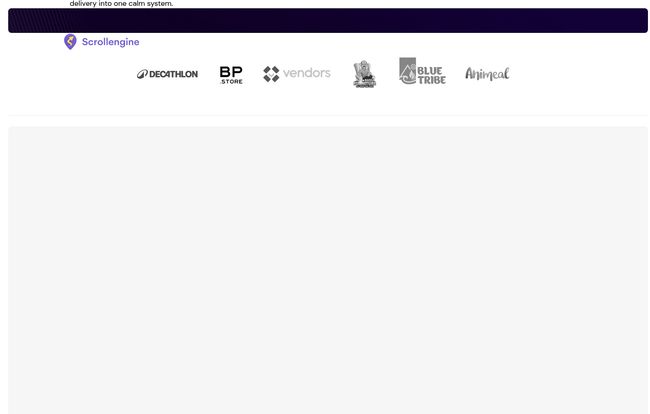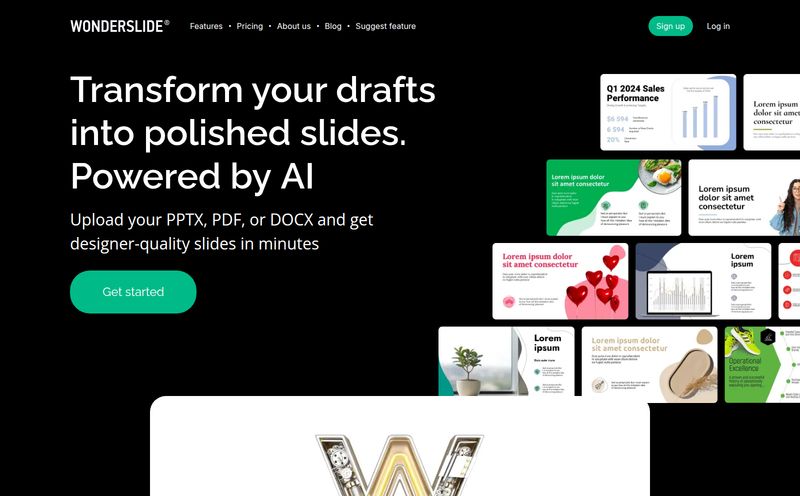If you're running an e-commerce business that handles its own deliveries, you know the special kind of chaos that ensues. You’ve got orders flying in, drivers waiting, and a constant stream of “Where’s my package?!” emails flooding your inbox. It’s enough to make you want to trade it all in for a quiet life raising llamas. I've been in the trenches of e-commerce traffic and operations for years, and I've seen firsthand how last-mile delivery can make or break a brand.
So, when I hear about a tool that claims to use AI to tame this beast, my ears perk up. The latest one to cross my desk is Scrollengine. It’s an AI-powered logistics platform built specifically with Shopify merchants in mind. The promise is tempting: smoother operations, happier customers, and fewer headaches. But as we know in the SEO and digital marketing world, promises are easy to make. The real question is, does it deliver? (Pun absolutely intended).
What Exactly is Scrollengine Supposed to Do?
Think of Scrollengine as the mission control for your local delivery operations. At its core, it’s designed to take the manual guesswork and spreadsheet juggling out of getting products from your warehouse or store into your customers' hands. It’s not a generic logistics software that you have to bend and twist to fit your needs; it’s purpose-built for the Shopify ecosystem. This is a big deal. When a tool integrates deeply with the platform you already use, it saves a world of pain.
They boast of being trusted by over 1,500 merchants, and their homepage casually drops some pretty big names like Decathlon and BP. That’s some serious social proof right there. It tells me they’re not just a fly-by-night startup; they're playing in the big leagues.
The Core Features That Actually Matter
A platform is only as good as its features, right? You can have all the fancy AI branding in the world, but if the tools don’t solve real problems, what’s the point? Here's what Scrollengine brings to the table.
AI-Optimized Routing: The Brains of the Operation
This is the headliner. Scrollengine’s AI doesn't just find the shortest path from A to B. It’s playing 4D chess with your delivery schedule. It considers traffic patterns, delivery windows, vehicle capacity, and the number of stops to create the most efficient routes possible for your drivers. This isn't just about saving a few minutes; it's about saving fuel, reducing wear and tear on vehicles, and fitting more deliveries into a single day. The company claims it can reduce your Non-Delivery Rate (NDR) by up to 60%. For any business, that’s a massive impact on the bottom line and customer satisfaction.
Keeping Everyone in the Loop: Tracking and Notifications
The single biggest cause of customer anxiety is the unknown. Scrollengine tackles this head-on with real-time driver tracking and automated customer notifications. Your customers can get a live map view of their delivery driver, just like they do with their Uber or DoorDash order. They get alerts when the delivery is started, when it's nearby, and when it's been completed. This transparency is gold. It transforms the customer experience from one of anxious waiting to one of confident expectation. And for you, the business owner? It means a dramatic drop in those time-consuming support calls and emails.
Proof of Delivery and Driver Apps: Closing the Loop
Ever dealt with a customer claiming they never received a package that your driver swears they delivered? It’s a frustrating he-said, she-said situation. Scrollengine’s Proof of Delivery (POD) feature ends that debate. Drivers can capture a photo, a signature, or notes right from their mobile app, creating a timestamped, geolocated record that the delivery was successful. The driver app itself is a huge plus, streamlining communication and putting all the necessary info right in their hands. A happy, efficient driver is a key ingredient for a successful delivery operation.
Seamless Shopify Integration (The Big One)
I’ve saved the best for last, because for me, this is the most compelling part. Scrollengine isn't just compatible with Shopify; it's native to it. It offers real-time order syncing, so as soon as an order comes in, it's ready to be routed. Even better, it has features like a checkout page integration and a delivery slot picker. This means your customers can choose their preferred delivery date and time right when they buy. This level of integration makes the whole process feel incredibly polished and professional, both for you and your customer. It’s not a bolt-on; it feels like a natural extension of your store.

Visit Scrollengine
The Good, The Bad, and The... Missing Page
Okay, so it sounds pretty great on paper. But I’m a professional skeptic. No tool is perfect. As I was digging around their site, I ran into something that perfectly sums up the pros and cons of a platform like this.
The Good Stuff (Why I'm Intrigued)
The advantages are clear and powerful. The AI routing is a genuine money and time saver. The boost in customer satisfaction from real-time tracking and notifications is undeniable. And the potential to slash failed deliveries is a game-changer. The tight Shopify integration is the cherry on top, making it an almost no-brainer for any serious local delivery business running on that platform.
The Not-So-Good Stuff (My Hesitations)
So, I went looking for the pricing page. It's the first thing I do when I evaluate any new tool. And I found… a “Page Not Found” error. Yep. A 404. Now, this could just be a temporary glitch, a simple website error. But it also points to my biggest frustration with many B2B SaaS platforms: a lack of transparent pricing. Instead of a clear pricing table, you're funneled towards a “Request a Demo” button. I get it, they want to qualify leads and tailor quotes, but as a potential user, I just want a ballpark figure without having to get on a sales call. It feels a bit old-school, and frankly, a little frustrating.
This also hints at the other cons. If you're not on Shopify, you'll need a custom setup, which probably means more complexity and cost. And it's safe to assume that the coolest features, like the advanced AI routing and checkout integrations, are reserved for the higher-tier, paid plans.
So, How Much Does Scrollengine Cost?
This is the million-dollar question, isn't it? And the short answer is: I don't know. As I mentioned, the pricing isn't publicly listed on their website. This usually means one of two things: the pricing is highly customized based on your order volume, number of drivers, and specific feature needs, or they are targeting enterprise-level clients where price is a much longer conversation. My advice? Don't be shy. If you’re serious, book the demo. But go in prepared. Know your monthly order volume, how many drivers you have, and which features are must-haves versus nice-to-haves. This will help you get a concrete quote and decide if the ROI is there for your business.
Who is This Really For?
Let's be clear, Scrollengine isn't for everyone. If you're a dropshipper or you use a 3PL for all your fulfillment, you can probably move along. This tool is built for the hands-on e-commerce business owner who manages their own local delivery fleet—even if that “fleet” is just you in a minivan on weekends.
I’m talking about businesses like:
- Local bakeries delivering fresh goods
- Florists doing event and home deliveries
- Furniture or appliance stores with their own trucks
- Meal-prep services with weekly routes
- Boutique clothing brands offering same-day local delivery
Some might argue, “I can just use Google Maps and a spreadsheet to plan my routes.” And you can! For a while. But once you're juggling more than a handful of orders a day, that system breaks down. Fast. That’s the moment when investing in a dedicated platform like Scrollengine starts to make a whole lot of sense.
My Final Verdict on Scrollengine
After digging in, I’m genuinely impressed with the potential of Scrollengine. It’s a sharp, focused tool that solves a very real, very expensive problem for a specific type of business. The deep Shopify integration is its superpower, and the feature set is robust and intelligent. It’s like graduating from a messy, manual process to a fully automated, intelligent system.
However, the lack of pricing transparency is a significant hurdle for me. It makes it hard to recommend without reservation. My final take is this: if you’re a Shopify merchant drowning in local delivery logistics, you owe it to yourself to at least request a demo. It could very well be the key to scaling your operations and reclaiming your sanity. Just be prepared to talk numbers.
Frequently Asked Questions about Scrollengine
- What is Scrollengine in simple terms?
- It's an all-in-one software for e-commerce businesses that handle their own local deliveries. It uses AI to plan the best routes for drivers, tracks them in real-time, and automatically keeps customers updated.
- Does Scrollengine only work with Shopify?
- It is built to integrate deeply and seamlessly with Shopify, which is its primary focus. The company states that a custom setup may be required for other platforms, so it's best to contact them directly if you're not on Shopify.
- How does Scrollengine reduce failed deliveries (NDR)?
- It helps in several ways. The AI-optimized routes ensure drivers are on time. The customer notifications and live tracking mean the customer knows exactly when to expect their package, so they’re more likely to be home. Finally, the delivery slot picker at checkout lets customers choose a time they know they'll be available.
- Is there a free trial for Scrollengine?
- Their website doesn't explicitly mention a free trial. This is a question you'd want to ask during the sales demo, as they may offer one on a case-by-case basis.
- What is 'Proof of Delivery' and why is it important?
- Proof of Delivery (POD) is a digital record that an order was successfully delivered. By allowing drivers to capture a photo or signature, it protects your business from fraudulent claims of non-receipt and provides peace of mind for both you and your customer.
- Can I customize the customer notifications?
- While not explicitly detailed, platforms like this almost always allow for customization of notifications to match your brand's voice and tone. It's a standard feature and a key part of maintaining a consistent customer experience.



